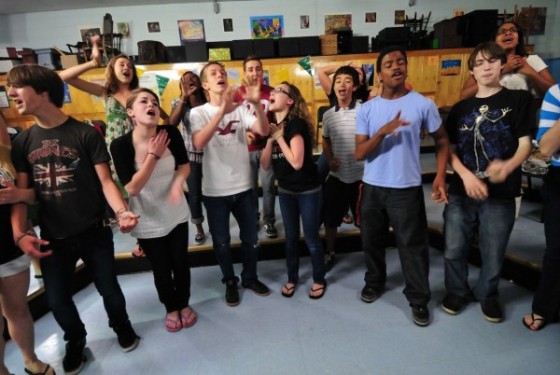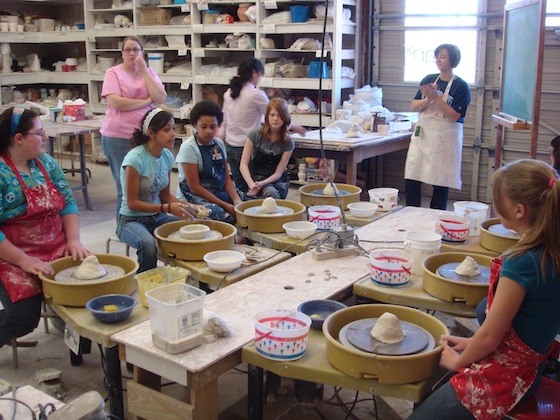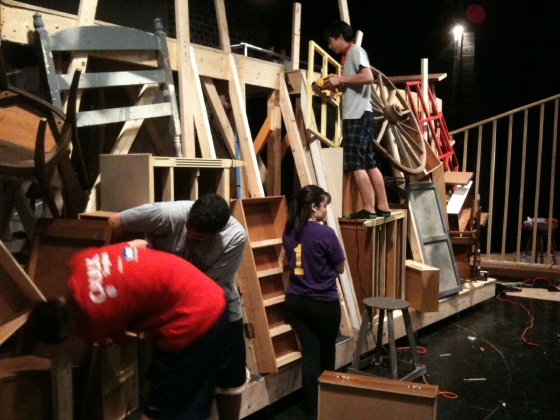PBL Experts Are All Around Us!
For a long time I’ve watched my husband Steve, a drama teacher, work his magic in his classes and dramatic productions. Lately, I’ve been reading posts from core subject teachers (e.g., science, math, history) who are beginning to move from the transmissive pedagogy more likely to be found in traditional subjects and wanting to explore a more student-centered, inquiry, or project-based approach.
This growing urge among teachers to put students center-stage has made me revisit some thoughts about the wealth of knowledge the arts teachers in our buildings have about this topic. The trouble is that they don’t often speak up. They quietly go about their work, often marginalized to the ‘extras’ or the ‘fluff’ of the school program — and yet, I would argue that they are the PBL experts that we seek!
Check out this quote from David Booth’s book called Story Drama. Doesn’t this sound a lot like the project-based classroom many of us yearn to create?
This is the drama teacher’s struggle: listening, watching, setting up situations that will foreshadow the direction of the journey, knowing when to intervene, when to use a particular strategy to open up discussion, to move the students into action, to cause them to pause, to reflect, to rethink, and all this without predetermining the learning, the content, the meat of the lesson.
What hit me is that this quote really typifies the kind of work we all ought to be doing in our classrooms. The delicate dance of teaching involves watching, inspiring, coaching, providing choices, respecting, motivating and providing rich content experiences…such a complex task indeed!
So what are the fundamentals that we might we borrow from the arts teachers to support student-directed learning in other domains?
Arts teachers know that knowledge is a private reflection until we give it social value
This is really the key to much of our discussion about 21st century learning these days. New tools afford us the opportunity to articulate our understanding in new ways and make it far more accessible — no longer just text-based, and no longer created for just one teacher, or just one class. Audiences have moved from the single classroom to the global community.
In much the same way that students are motivated by the performances in arts education, student engagement goes up when students are creating artifacts to share with their community, either virtually or face to face — or they correspond with people who have experiences to share that relate to their own studies — or they bring their questions and new understandings to experts (e.g., scientists, authors, or other classes) via online conversations.
Arts teachers know how to build communities where all voices are valued and taking risks is safe
This might be one of the most difficult parts of transforming the classroom from a teacher-directed space to a student-focused space. Arts teachers have expertise in this area.
New skills such as accountable talk, self-regulation, and the ability to build and maintain a comfortable, equitable and safe space for communicating need to be acquired by both teachers and students. How does that happen in an arts classroom? Team-building, trust-building, conflict resolution and teacher modeling of effective feedback helps that emerge over time. Routines are established that teach students how to cooperate; how to lead sometimes, and how to be led by peers other times.
In the arts classroom, effective teachers also participate as co-learners; sometimes leading, sometimes letting students take the lead, always modeling the kinds of interactions they are hoping to see within the learning community. It’s crucial that they sometimes play the role of ‘student’ in order to do this modeling of what learning looks like.
Not only do arts educators create supportive social environments, they promote risk-taking by stressing the real work of the arts. Students BECOME actors, painters, dancers and musicians and they explore with the teacher who invites them into this ‘tribe’ through modeling the ways of BEING and DOING in their particular domain.
Shouldn’t this happen in other subject areas? As Seymour Papert puts it: “(B)eing a mathematician, again like being a poet or a composer or an engineer, means doing rather then knowing or understanding.” Authentic projects can bring students into “being and doing” as they personally connect to curriculum. We don’t have to be arts educators to employ this potent learning strategy.
Arts teachers are skilled at differentiation
Differentiation is the name of the game in the arts classroom. Most often the courses are open, bringing together students with a variety of backgrounds and abilities. Individuals are valued for their unique strengths that make team work more effective. Through the use of technology, teachers in other subject areas are beginning to see how students can blend images, sound, music, and text to create powerful messages and artifacts that allow all students to be successful.
Teachers of the arts know this secret: feedback that is immediate, descriptive and supportive of the whole group changes the role of assessment — and students often share in this process through peer and self-assessment.
Arts teachers approach learning as a balance of process & product with a focus on reflection
Arts educators believe that process, structures and techniques are important to their craft, and that since the arts are meant to be shared, a product is equally important. This understanding of balance keeps the focus on acquiring and improving skills while also creating public artifacts that demonstrate this learning.
The work of the arts is never quite finished, and reflection is a constant part of the process. Imagine rich portfolios of students’ work as scientists, historians or mathematicians, expanding and demonstrating increasing mastery throughout their years at school.
So how do you get help from teachers of the arts?
One thing is a given – inquiry-based approaches involve following students along paths that you might not be able to predict – and that involves responsive teaching. I’d recommend that you go and search out your arts teachers. They are usually really passionate about their subject area, just as you are, and may be eager to share their expertise.
For starters you might ask some of these questions to get a conversation going (and glean an invitation to observe):
- What techniques are used to build an effective community of learners?
- What strategies and structures are put in place to manage a classroom that focuses on discussion, sharing and reflection?
- How do teachers handle the fact that the endpoint isn’t always what is planned or expected?
You may also be interested in this collection of lesson plans, websites and PD resources for Arts Integration recently gathered by Edutopia.
Images (from top): NEA Today, Creative Commons, Ed Allen



